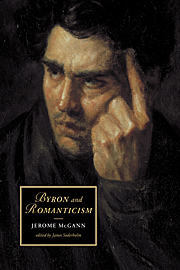Book contents
- Frontmatter
- Contents
- Acknowledgments
- General analytical and historical introduction
- PART I
- PART II
- 10 A point of reference
- 11 History, herstory, theirstory, ourstory
- 12 Literature, meaning, and the discontinuity of fact
- 13 Rethinking Romanticism
- 14 An interview with Jerome McGann
- 15 Poetry, 1780–1832
- 16 Byron and Romanticism, a dialogue (Jerome McGann and the editor, James Soderholm)
- Subject index
- Authors index
- CAMBRIDGE STUDIES IN ROMANTICISM
12 - Literature, meaning, and the discontinuity of fact
Published online by Cambridge University Press: 22 September 2009
- Frontmatter
- Contents
- Acknowledgments
- General analytical and historical introduction
- PART I
- PART II
- 10 A point of reference
- 11 History, herstory, theirstory, ourstory
- 12 Literature, meaning, and the discontinuity of fact
- 13 Rethinking Romanticism
- 14 An interview with Jerome McGann
- 15 Poetry, 1780–1832
- 16 Byron and Romanticism, a dialogue (Jerome McGann and the editor, James Soderholm)
- Subject index
- Authors index
- CAMBRIDGE STUDIES IN ROMANTICISM
Summary
Textual studies and editing are two exemplary fields of historical criticism. They are also fundamental, since all literary work is grounded in them. These subdisciplines of historical criticism have been dominated for many years by empirical and even positivist methods and goals, sometimes for good, sometimes for ill. That general context has led me to concentrate much of my work in textual criticism and theory. I have done so with two particular goals in view.
First, I wanted to attack traditional historicism in what has always been regarded as its fastness of strength, its (hitherto) impregnable inner tower: textual studies and editing. Second, I wanted to open a parallel critique of contemporary theory and hermeneutics, which has largely avoided a serious engagement with the problem of facticity and positive knowledge. The unwillingness or inability of most influential literary theoreticians of the past twenty-five years to enter the fields of textual criticism and editing is an eloquent historical fact. Even when theoretically sophisticated critics moved beyond a “hermeneutics of reading” into various kinds of “new historical” and “cultural” studies, they did so typically without having addressed the conflicting claims of fact and idea, writing and reading, history and interpretation.
In textual studies and editing, however, these issues cannot be evaded, because the editor's and textual critic's literary works are always encountered as specific, material historical forms. They have what Paul de Man, speaking for hermeneutics generally, said “literary texts” cannot have: “positive existence.”
- Type
- Chapter
- Information
- Byron and Romanticism , pp. 231 - 235Publisher: Cambridge University PressPrint publication year: 2002

